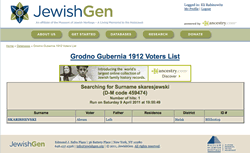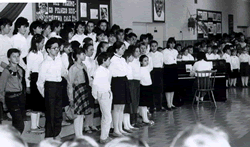|
Bialystok is in current day Poland, about 30 miles west of the border with The city has been part of Poland since the country of Poland was ** Before the partition of the Poland - Lithuania Commonwealth (1772-1795), ** In the third partition in 1795, Bialystok became part of East Prussia ** In 1807, Bialystok passed to Russia and was subsequently in Grodno ** After WWI, Bialystok was claimed by Belarusian Republic and the Soviet Bialystok was part of Grodno Gubernia during the period when most of our Mark Halpern |
Subject: Bialystoker Center Yahrzeit Card Index Now Online From: "Mark Halpern" <bialystoker@comcast.net> Date: Thu, 24 Jul 2008 15:39:12 -0400 X-Message-Number: 19 BIALYGen, the Bialystok Region Jewish Genealogy Group, has added a database of The Yahrzeit Card database is derived from cards maintained by The Bialystoker This static database is now online and can be accessed via links at To obtain JPEG images of Yahrzeit cards for your family, please email me at I would like to thank The Bialystoker Center for their help and permission I hope this database provides some help with your search. Mark Halpern |
| 1. I would like to know more information about Zolta Street In Bialystok. I think, there is a yeshiva presided by a Zolty
family. I would like to have the genealogical tree of the family... Best regards, Franck d'Almeida-Zolty |
Bublacki family of Hajnowka, Bialystock & Slonim. (dalefarmer@ntlworld.com) on
Message: Thank you for your wwwsite, from information found we traced family |
| My great-uncle, Majer (Meier, Meyer) INGBERG, lived in Bialystok. He resided at Polna 19 or 17 in the 1930's. He was born around 1877 in Warsaw. It is my understanding that he owned a factory/shop which made leather goods. He had three sons, one named Moshe, and one daughter, possibly named Paula. One of the sons married a girl who was a teacher. I also have a letter dated 1933 from a Dr. H. Lukaczewski indicating that my great-uncle had arteriosclerosis. I recently sent a message to the Archives in Bialystok. Record office inform in bialystok kindly, that we lack in local stock: I had hoped there would be some way to trace my Uncle through the Elizabeth Jackson |
From: Eli Rabinowitz <elirab@iinet.net.a> My great grandfather was Avram Skarishevski from Orla near Bialystok, married to a Rochel Guta Rishilevski. If you find any connection, let me know. I am visiting Bialystok / Orla in May. Cheers Eli Rabinowitz Perth Australia |
Dear Friend, ****** SCREENPLAY: Black and white. "The Pencil”. Starter. 1. Distant shot: an outline of dense town architecture (2 -3 takes) 2. Shot: a yard, condominium-like in character. 3 girls are playing hopscotch. One first-floor window open. Below it - the entrance to the building (staircase). 3. Interior shot. A woman is stirring soup in a pot. Shot of soup. In the background: a boy reading something, (studying?), playing with a pencil, behind him clear shot of an open window. In the background: sounds of conversation (in Polish), jumping, something hitting against the cobblestones, sounds of throwing stones, girls' giggling. 5. Although the boy controls himself as much as he can, he can't bear it much longer. Enters the boy's father. 6. The boy continues playing his game. These shots are very fast (very brief cuts) 8. The boy, resigned, returns to his studies. -------------------------------------------------------------- |
| My ancestor (gg grandfather) Isaac Bublacki (1846-1910) and his brother Hyman (1857-1934), both born in Bialystok according to their naturalisation papers, arrived in England about 1877 and 1900 respectively, and adopted the surname Simons, presumably after their father Shima Bublacki (d. c. 1899). (I believe that both Shima and Hyman retired to Jerusalem before their death and are buried there). Hyman married Esther Greenberg about 1876 in Bialystok and their 13 children, six of whom died in infancy, were born in Bialystok or thereabouts. His eldest son, Abraham (b. 1876/7) returned to Bialystok to marry after the family had moved to London. In 1 904 he married Sarah Pearl Pawelski, and he is recorded in the 1912 Bialystok voters list. They had four children all of whom survived the war – I am not clear about the fates of their parents. Isaac’s death notice ion the Jewsih Chronicle 'African and American papers, please copy' - therefore there were almost certainly Simons/Bublacki relatives (?brothers/sisters) in those continents. I note the Bublackis listed in your website and am intrigued as to whether they can be linked to my family. Clearly Shima, Isaac and Hyman were part of a large family but I have never been able to identify links with other Bublackis. For example, a candidate is Chana Bublacka, who married Israel Leib Friedman (b. 1835) and gave birth to Josef Isaac Friedman (who settled in America) in 1866. According to her descendant Michelle Gillmann, Chana's children were born in the villages of Lunna and Volpa (about 25km E. of Bialystok). Michelle reports that Chana is said to have died in Jerusalem and to be buried on the Mount of Olives (cf. My family stories about Shima and Hyman Bublacki). Both Isaac and Hyman Simons named a daughter Annie (=Chana). If you have any views or comments on the above, I should be very interested to receive them. I have fairly complete trees of the descendants of Isaac and Hyman. Yours sincerely, David Conway (London) |
From: David Conway <smerus@gmail.cm> My ancestor (gg grandfather) Isaac Bublacki (1846-1910) and his brother Hyman (1857-1934), both born in Bialystok according to their naturalisation papers, arrived in England about 1877 and 1900 respectively, and adopted the surname Simons, presumably after their father Shima Bublacki (d. c. 1899). (I believe that both Shima and Hyman retired to Jerusalem before their death and are buried there). |
Hi Friend This - below - letter I send to some people around the world. Maybe You will find a sense to help in this short film related to Krynki. Would be nice to resend this my letter to some others KRYNKER's www.youtube.com/watch?v=jfTP1FceXdc Film about Krynki is not going to participate in any competition. |
Dear Ladies and Gentleman, I´m a young filmmaker and artist from Austria and work currently on a essayistic film about the history of the city Bialystok. The film will be a reflection of the past till the nowadays and the question what will come and how we can ready the history of a city for a deeper understanding of political changes in general. Especially when we see the frightening changes in Europe nowadays. The film brings a lot of things together, like the first Anarchist movement in Bialystok, Jewish Partisan movements, Jewish uprising, Ghetto, the Holocaust, multi ethnical city, Zamenhof, Dziga Vertov, Anarchist Movement in 2000 to Neonazi Movement. In short hand, it´s a film that reflects changement, resistance and history. Therefor I researched quite a lot and found the website http://www. eilatgordinlevitan.com/ bialystok/bialystok.html with a lot of interesting photographs which could be interesting for the film. For example: http://www.eilatgordinlevitan. com/bialystok/bial_pix/front/ 041808_13_b.gif http://www.eilatgordinlevitan. com/bialystok/bial_pix/front/ 041808_31_b.gif http://www.eilatgordinlevitan. com/bialystok/bial_pix/front/ 062012_64_b.gif Therefor I wonder who I can contact regarding the rights and use of this images in the film. Thanks for your time and looking forward to hear from you, Johannes Gierlinger |
From: ivanka <ivanka@interia.pl> hello I recognize my School in Bialystok number 31 in name Henryk Goldshmit (Janusz Korczak). I remember since I was 7 we every year remember in our school of uprising in Bialystoker ghetto and in Warsaw. We sang Shallom Alejhem and it was very important for us to remember. A ceremony in School No. 31 in Bialystok, Poland. After World War II |
From: Esther Werdiger <ewerdiger@tabletmag.com> Hi! Tablet Magazine is looking for some Bialystok Ghetto Uprising images for a story running this week. Would we be able to use any of photos here? http://www.eilatgordinlevitan.com/bialystok/bialystok.html -- |
|
Bialystok Remembers Bia?ystok Pami?ta - Bia?ystok remembers 27.VI.1941 - 27.VI.2020 |

